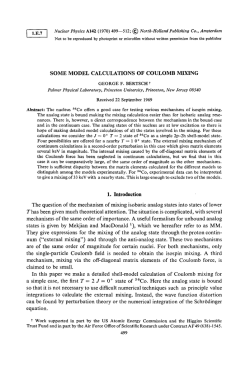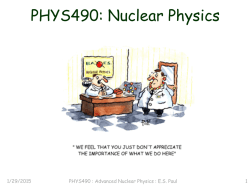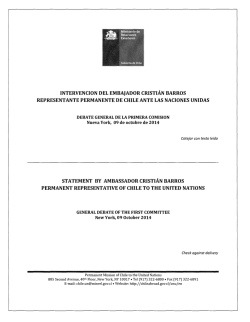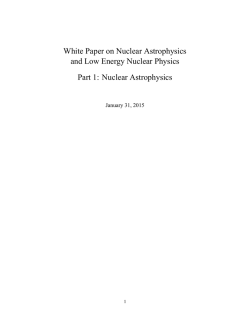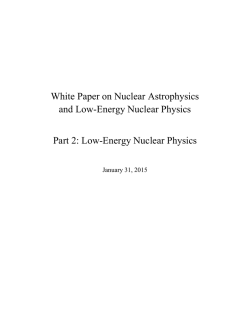
1 - arXiv.org
Neutron star equations of state with optical potential constraint arXiv:1501.07393v1 [nucl-th] 29 Jan 2015 S. Anti´ca,b,∗, S. Typela a GSI b Helmholtzzentrum f¨ ur Schwerionenforschung GmbH, Planckstraße 1, D-64291 Darmstadt, Germany Technische Universit¨ at Darmstadt, Schlossgartenstraße 2, D-64289 Darmstadt, Germany Abstract Nuclear matter and neutron stars are studied in the framework of an extended relativistic mean-field (RMF) model with higher-order derivative and density dependent couplings of nucleons to the meson fields. The derivative couplings lead to an energy dependence of the scalar and vector self-energies of the nucleons. It can be adjusted to be consistent with experimental results for the optical potential in nuclear matter. Several parametrisations, which give identical predictions for the saturation properties of nuclear matter, are presented for different forms of the derivative coupling functions. The stellar structure of spherical, non-rotating stars is calculated for these new equations of state (EoS). A substantial softening of the EoS and a reduction of the maximum mass of neutron stars is found if the optical potential constraint is satisfied. Keywords: Relativistic mean-field model, Equation of state, Nuclear matter, Neutron stars, Density-dependent coupling, Derivative coupling, Optical potential 1. Introduction 5 10 The recent observation of two pulsars with approximately two solar masses [1, 2] presents a severe challenge to the theoretical description of cold highdensity matter in β-equilibrium. The equation of state (EoS) has to be sufficiently stiff in order to support such high masses of compact stars. Many models that are solely based on nucleonic (neutrons and protons) and leptonic (electrons and muons) degrees of freedom are able to reproduce maximum neutron star masses above two solar masses if the effective interaction between the nucleons becomes strongly repulsive at high baryon densities. However, additional hadronic particle species can appear at densities above two or three times the nuclear saturation density nsat ≈ 0.16 fm−3 . In most cases, these additional degrees of freedom lead to a substantial softening of the EoS resulting in a reduced ∗ Corresponding author Email addresses: [email protected] (S. Anti´ c), [email protected] (S. Typel) Preprint submitted to Nuclear Physics A January 30, 2015 15 20 25 30 35 40 45 50 55 maximum mass of the compact star below the observed values. This feature is well-known for models with hyperons – the so-called ”hyperon puzzle”, see, e.g., [3, 4] and references therein – but was also observed in approaches that take excited states of the nucleons such as ∆(1232) resonances into account, see, e.g., [5, 6] and references therein. Usually, only specifically designed interactions can avoid the problem of too low maximum masses. Successful models of the baryonic contribution to the stellar EoS should be scrutinized whether they comply with other experimental contraints, e.g. with respect to the employed interactions. In the center of compact stars very high baryon densities are reached exceeding several times nsat and the corresponding Fermi momenta of the particles are much larger than those at saturation. This is particularly significant for models with only nucleonic degrees of freedom. Hence, not only the density dependence of the effective in-medium interaction between nucleons but also their momentum dependence becomes relevant. For densities near nsat this information is contained in the optical potential of nucleons that can be extracted from the systematics of elastic proton scattering on nuclei, see, e.g., [7, 8]. A saturation of the real part of the optical potential is observed at high kinetic energies approaching 1 GeV. The momentum dependence of the in-medium interaction is also crucial in simulations of heavy-ion collisions [9]. Typical approaches for the baryonic contribution to the stellar EoS are energy density functionals that originate from nonrelativistic or relativistic meanfield models of nuclear matter. The most prominent cases among the former class are Skyrme energy density functionals, see reference [10] for an overview of different parametrizations. They are derived originally from the zero-range Skyrme interaction with a two-body contribution, which is an expansion up to second order in the particle momenta, and a density dependent three-body contribution, which is included in order to reproduce saturation properties of nuclear matter. Obviously, an extrapolation of the model to high momenta is questionable given the limited form of the momentum dependence. Examples of the latter class, frequently denominated covariant density functionals, can be inferred from relativistic Lagrangian densities. In conventional models, see reference [11] for a wide collection of different parametrizations, a nucleon optical potential in the medium can be derived from the relativistic scalar and vector self-energies, see section 5. It exhibits a linear increase with energy, which is in contradiction with the expectation from experiment. In general, one would expect that the nucleon self-energies itself depend explicitly on the particle momentum or energy as, e.g., in Dirac-Brueckner calculations of nuclear matter [12]. However, this is not realized in standard RMF models. There are particular extensions of relativistic mean-field (RMF) models that contain nucleon self-energies with an explicit energy or momentum dependence. This dependence cannot be introduced in a relativistic model in a simple parametric form because it affects, e.g., the definition of the conserved currents. In extended systematic approaches new derivative couplings between the nucleon and meson fields are introduced that allow to reproduce the energy dependence of the optical potential as extracted from experiments. One of the earliest 2 60 65 70 75 80 85 90 95 100 RMF models with scalar derivative couplings was presented in reference [13]. A rescaling of the nucleon fields removed the explicit momentum dependence of the self-energies but lead to a considerable softening of the EoS. More general couplings of the mesons to linear derivatives of the nucleon fields were considered in reference [14] with an application to uniform nuclear matter. With appropriately chosen coupling constants a reduction of the optical potential was found as compared to the strong linear energy dependence in convential RMF models. The model was further extended in reference [15] assuming a density dependence of the couplings. It was successfully applied to the description of finite nuclei. Notable new features were the increase of the effective nucleon masses (usually rather small in order to explain the strong spin-orbit interaction in nuclei) and correspondingly higher level densities close to the Fermi energy in nuclei in better concordance with expectations from experiments. Though, using couplings only linear in the derivatives leads to a quadratic dependence of the optical potential on the kinetic energy with a decrease for energies exceeding 1 GeV. Couplings to all orders in the derivative of the nucleons were introduced in the so-called nonlinear derivative (NLD) model [16, 17] assuming a particular exponential dependence on the derivatives but no density dependence of the couplings. The general formalism was developed and applied to infinite isospin symmetric and asymmetric nuclear matter. In reference [18] the approach was slightly modified with a derivative momentum dependence of Lorentzian form and additional nonlinear self-couplings of the σ meson field in order to improve the description of characteristic nuclear matter parameters at saturation. The application of this version of the NLD model to stellar matter yielded a maximum neutron star mass of 2.03 Msol barely satisfying the observational constraints but the dependence of the result on the model parameters was not explored in detail. In this work we introduce a more flexible extension of the nonlinear derivative model assuming density dependent meson-nucleon couplings in addition. Instead of using derivative operators that generate an explicit momentum dependence of the self-energies, we will use a functional form that leads to an energy dependence. This approach will also be more suitable for a future applications of the DD-NLD approach to nuclei since the relevant equations and their numerical implementation are simplified. Here, the equations of state of symmetric and asymmetric nuclear matter will be calculated for different choices of the derivative coupling operators that lead to a saturation of the optical potential at high energies as derived from experiments. They are compared to the results of a standard RMF model with density dependent couplings that is consistent with essentially all modern constraints for the characteristic nuclear matter parameters at saturation. The parameters of the DD-NLD models are chosen such that these saturation properties are reproduced. The effect of the optical potential constraint on the mass-radius relations of neutron stars will be studied. The paper is organized as follows: In section 2 the Lagrangian density of the DD-NLD approach is presented. The field equations in mean-field approximation and the energy-momentum tensor will be derived. The relevant equations 3 105 110 for the case of infinite nuclear matter will be considered in more detail in section 3. The parametrization of the density dependent couplings and the functional form of the derivative coupling functions is discussed in section 4. Results for the energy dependence of the optical potential, the EoS of nuclear matter and the mass-radius relation are presented in section 5 for various versions of the model. Conclusions are given in section 6. Detailed expression for various densities are collected in Appendix A. 2. Lagrangian density and field equations of the DD-NLD model In most RMF models the effective interaction between nucleons is described by an exchange of mesons. Usually, σ and ω mesons are introduced to consider the attractive and repulsive contributions to the nucleon-nucleon potential, respectively. They are represented by isoscalar Lorentz scalar and Lorentz vector fields σ and ωµ . In order to model the isospin dependence of the interaction, the exchange of ρ mesons is included. It is denoted by the isovector Lorentz vector field ρµ in the following. The Lagrangian density in the DD-NLD approach1 L = Lnuc + Lmes + Lint (1) contains contributions of the free nucleons Ψ = (Ψp , Ψn ) with mass m Lnuc = − → ← − 1 Ψγµ i∂ µ Ψ − Ψi∂ µ γµ Ψ − mΨΨ 2 in a symmetrized form and of free mesons 1 1 (ω) (ω)µν Lmes = ∂µ σ∂ µ σ − m2σ σ 2 − Fµν F + m2ω ωµ ω µ 2 2 1 (ρ) (ρ)µν − Fµν F + m2ρ ρµ ρµ 2 (2) (3) with the field tensors (ω) Fµν = ∂µ ων − ∂ν ωµ 115 (ρ) and Fµν = ∂µ ρν − ∂ν ρµ (4) of the isoscalar ω meson and the isovector ρ meson, respectively. The arrows in equation (2) denote the direction of differentiation. Standard RMF models assume a minimal coupling of the nucleons to the meson fields leading to Lint = Γσ σΨΨ − Γω ωµ Ψγ µ Ψ − Γρ ρµ Ψτ γ µ Ψ (5) for the interaction contribution to the total Lagrangian density L with mesonnucleon couplings Γi (i = σ, ω, ρ). We assume that they depend on the vector 1 Natural units with ¯ h = c = 1 are used in the following. 4 density nv , see equation (26) for the explicit definition. In the derivative coupling model the nucleon field Ψ (Ψ) is replaced in Lint by Dm Ψ (Dm Ψ) with operator functions Dm , which can be different for the various mesons m = σ, ω, ρ. They can be expanded in a series Dm (x) = ∞ (m) X dn xn n! n=0 (6) (m) with numerical coefficients dn . The argument x contains derivatives i∂β that act on the nucleon field. More specifically we write x = v β i∂β − sm (7) as a hermitian Lorentz scalar operator with an auxiliary Lorentz vector v β = (v0 , ~v ) and a scalar factor s. Hence the interaction contribution in the NLD model is written as ← − → − 1 Lint = (8) Γσ σ Ψ D σ Ψ + Ψ D σ Ψ 2 → − ← − 1 − Γω ωµ Ψ D ω γ µ Ψ + Ψγ µ D ω Ψ 2 ← → − − 1 − Γρ ρµ Ψ D ρ γ µ τ Ψ + Ψτ γ µ D ρ Ψ 2 in a symmetrized form with respect to the derivative operators Dm , i.e., − → Dm = ← − Dm = ∞ X k=0 ∞ X (m) → − (v β i ∂ β )k (m) ← − (−v β i ∂ β )k Ck Ck (9) (10) k=0 (11) with coefficients (m) Ck k (m) X n dn (−sm)n−k . = n! k n=0 (12) (m) 120 125 Obviously, no derivatives appear for the choice Dm = 1 (corresponding to dn = δn0 ) and the standard form (5) is recovered. When spatially inhomogeneous systems with Coulomb interaction are considered, Lmes and Lint can be complemented with the appropriate contributions. Since only uniform matter is considered in the following, we do not give them here explicitly. The field equations of nucleons and mesons are derived from the generalized Euler-Lagrange equation ∞ X ∂L ∂L (−)i ∂α1 ,...,αi + =0 ∂ϕr i=1 ∂(∂α1 ,...,αi ϕr ) 5 (13) for all fields φr = Ψ, Ψ, σ, ωµ , ρµ of the model. Details can be found in references [16, 18]. The Dirac equation [γµ (i∂ µ − Σµ ) − (m − Σ)] Ψ = 0 (14) for the nucleons looks formally the same as in standard RMF approaches but the scalar (Σ) and vector (Σµ ) self-energie operators now contain the derivative operators Dm . They are given by and → − Σ = Γσ σ D σ (15) → − → − Σµ = Γω ω µ D ω + Γρ τ · ρµ D ρ + ΣµR (16) with the ’rearrangement’ contribution jµ → − − 1 ← µ ΣR = Ψ D ω γν Ψ + Ψγν D ω Ψ Γ′ω ω ν nv 2 ← − → − 1 +Γ′ρ ρν Ψ D ρ γν τ Ψ + Ψγν τ D ρ Ψ 2 → − − 1 ′ ← − Γσ σ Ψ D σ Ψ + Ψ D σ Ψ 2 containing derivatives Γ′i = 130 dΓi dnv (17) (18) of the coupling functions. In the case of inhomogeneous systems and a nonvanishing three-vector component ~v of the auxiliary vector v β , additional contributions in (15) and (16) will appear. In the present application of the DD-NLD model, however, we do not consider this case. The field equations of the mesons are found as − → − 1 ← (19) Γσ Ψ D σ Ψ + Ψ D σ Ψ ∂µ ∂ µ σ + m2σ σ = 2 ← − → − 1 (20) ∂µ F (ω)µν + m2ω ω ν = Γω Ψ D ω γ ν Ψ + Ψγ ν D ω Ψ 2 → − ← − 1 (21) ∂µ F (ρ)µν + m2ρ ρν = Γρ Ψ D ρ γ ν τ Ψ + Ψτ γ ν D ρ Ψ 2 with source terms containing derivative operators. The conserved baryon current in the DD-NLD model is given by X hΨi N µ Ψi i Jµ = (22) i=p,n with the norm operator N µ = γ µ + Γσ σ ∂pµ Dσ − Γω ωα γ α ∂pµ Dω − Γρ ρα γ α τ ∂pµ Dρ 6 (23) where ∂pµ Dm is the derivative of Dm operator with respect to the momentum pµ = i∂µ , i.e. ∞ X (m) ∂pµ Dm = v µ kCk (v β i∂β )k−1 , (24) k=1 and h. . . i denotes the summation over all occupied states. The current (22) is not identical to the vector current X hΨi γ µ Ψi i , Jvµ = (25) i=p,n which is used to define the vector density q nv = Jvµ Jvµ (26) appearing as the argument of the coupling functions Γi . The energy-momentum tensor assumes the form X (27) hΨi N µ pν Ψi i − g µν hLi . T µν = i=p,n Then energy density ε and pressure p are found from ε = T 00 and p = P3 the ii i=1 T /3, respectively. 135 3. DD-NLD model for nuclear matter In the case of stationary nuclear matter, the equations simplify considerably since the system is homogeneous and the meson fields, which are treated as classical fields, are constant in space and time. Positive-energy solutions of the Dirac equation (14) are plane waves Ψi = ui exp (−ipµi xµ ) for protons and neutrons with Dirac spinors ui , which are normalized according to Ψi N 0 Ψi = u ¯ i N 0 ui = 1 (28) with the time component of the norm operator (23). They depend on the effective mass m∗i = mi − Σi (29) and effective momentum µ µ p∗µ i = p i − Σi (30) related by the dispersion relation ∗ ∗ 2 p∗µ i piµ = (mi ) . (31) The derivative i∂ β in the Dm operators can be replaced by the corresponding four-momentum pβi = (Ei , ~ pi ) resulting in a simple function Dm depending on the energy Ei and the momentum p~i of the nucleon. 7 Using the identity α N µ Ψi = γ µ + ∂pµ Σi − γα ∂pµ (Σα i − ΣR ) Ψ i (32) the conserved current and the energy-momentum tensor can be written as Z X d3 p Πµi κi Jµ = (33) (2π)3 Π0i i=p,n and T µν = X κi i=p,n Z d3 p Πµi pν − g µν hLi , (2π)3 Π0i (34) respectively, with the four-momentum i h β β µ ∗ µ ∗ Σ − Σ ∂ − p ∂ Σ Πµi = p∗µ + m i p iβ p i i i R (35) and spin degeneracy factors κi = 2. The integration runs over all momenta p with modulus lower than the Fermi momenta pF i in the no-sea approximation. They are defined through the individual nucleon densities ni = 140 145 κi 3 p . 6π 2 F i (36) Without the preference for a particular direction in infinite nuclear matter, the spatial components of the Lorentz vector meson fields vanish and the auxiliary vector in equation (7) is set to v β = δβ0 such that the Dm functions only depend on the nucleon energy Ei . Without isospin changing processes, only the third component of the isovector ρ field has to be considered in the field equations for the mesons. Using the abbreviations ω = ω 0 and ρ = ρ03 the meson fields are immediately obtained from σ = Γσ Γσ X hΨi Dσ Ψi i nσ = 2 2 mσ mσ i=p,n (37) ω = Γω X Γω hΨi γ 0 Dω Ψi i nω = 2 2 mω mω i=p,n (38) ρ = Γρ X Γρ hΨi γ 0 τ3 Dρ Ψi i nρ = 2 2 mρ mρ i=p,n (39) with source densities nσ , nω , and nρ . The self-energies simplify to Σi = Γσ σDσ (40) Σ0i ~i Σ = Γω ωDω + Γρ τ3,i ρDρ + Σ0R (41) = 0 (42) with τ3,i = 1 (−1) for protons (neutrons) and the ’rearrangement’ contribution Σ0R = Γ′ω ωnω + Γ′ρ ρnρ − Γ′σ σnσ 8 (43) independent of the nucleon energy. The dispersion relation reads q 2 Ei = p2 + (mi − Si ) + Vi (44) if we introduce the energy-dependent scalar potentials Si (E) = Σi and vector potentials Vi (E) = Σ0i . Explicit expressions for the various densities and thermodynamic quantities of the DD-NLD model are given in Appendix A. 150 4. Parametrization of the DD-NLD model 155 For the application of the NLD model to nuclear matter the parameters need to be specified. Besides the usual parameters of a RMF model with density dependent couplings the form of the Dm functions has to be given. We assume identical functions for all mesons, i.e. D = Dσ = Dω = Dρ , and consider three functional dependencies: D1 a constant D = 1, which corresponds to a usual RMF model with density dependent couplings, D2 a Lorentzian form D = 1/(1 + x2 ), D3 an exponential dependence D = exp (−x) with x = (Ei − mi )/Λ because we set v β = δβ0 and s = 1 in equation (7). The parameter Λ regulates the strength of the energy dependence. For the proton and neutron masses the experimental values of mp = 938.272046 MeV/c2 and mn = 939.565379 MeV/c2 , respectively, are used. The meson masses are set to mσ = 550 MeV/c2 , mω = 783 MeV/c2 , and mρ = 763 MeV/c2 . The density dependence of the meson nucleon couplings has the same form as introduced in reference [19]. For the isoscalar mesons m = σ, ω it is written as Γm (nv ) = Γm (nref )fm (x) with functions fm (x) = am 1 + bm (x + dm )2 1 + cm (x + dm )2 (45) (46) that depend on the argument x = nv /nref and contain coefficients am , bm , cm , and dm . For the ρ-meson coupling we set Γρ = Γρ (nref ) exp [−aρ (x − 1)] . 160 165 (47) In order to reduce the number of independent parameters we demand that the conditions fσ (1) = fω (1) = 1 and fσ′′ (0) = fω′′ (0) = 0 hold. Hence, there are only two independent coefficients in the functions fm for each of the isoscalar mesons. The overall magnitude of the couplings is given by the couplings Γm (nref ) at a reference density nref . We require that the characteristic saturation properties for the three choices of the D function are identical and close to current values extracted from experiments. In particular, we set the saturation density to 9 Table 1: Parameters of the meson coupling functions for three choices of the D functions and different values of cut-off parameter Λ. meson 170 175 180 parameter D1 D2 D3 Λ [MeV] − 400 500 600 700 σ Γσ (nref ) aσ bσ cσ dσ 10.72913 1.36402 0.53404 0.86714 0.62000 10.93466 1.35816 0.51914 0.83989 0.62998 10.86315 1.36015 0.52433 0.84931 0.62648 9.74679 1.38410 0.61515 1.00615 0.57558 9.89158 1.38064 0.60127 0.98211 0.58258 ω Γω (nref ) aω bω cω dω 13.29858 1.3822 0.42253 0.71932 0.60473 13.56462 1.3822 0.42253 0.71932 0.68073 13.47215 1.3822 0.42253 0.71932 0.68073 12.0503 1.3822 0.42253 0.71932 0.68073 12.23457 1.3822 0.42253 0.71932 0.68073 ρ Γρ (nref ) aρ 3.59367 0.48762 3.67852 0.48954 3.64957 0.48872 3.18819 0.34777 3.25233 0.36279 nref [fm−3 ] 0.15000 0.14618 0.147485 0.16515 0.16268 nsat = 0.15 fm−3 , the binding energy per nucleon at saturation to B = 16 MeV, the compressibility to K = 240 MeV, the symmetry energy to J = 32 MeV and the symmetry energy slope coefficient to L = 60 MeV. Furthermore, we set the effective nucleon mass at saturation to meff = 0.5625 mnuc (related to the strength of the spin-orbit potential in nuclei) and fix the ratios fω′ (1)/fω (1) = −0.15 and fω′′ (1)/fω′ (1) = −1.0 in order to determine the coefficients in the functions fm uniquely. These values are close to those of the parametrization DD2 [20] that was fitted to properties of nuclei and predicts a neutron star maximum mass of 2.4 Msol . Explicit values of the model parameters are given in table 1 with two choices of the cut-off parameter Λ for the cases of Lorentzian and exponential functions D. Note that the coefficients of the function fω are identical for all five parametrizations due to the constraints. The reference density nref is not necessarily identical to the saturation density nsat because in the case of explicit derivative couplings the vector density nv is different from the conserved baryon density nB = J 0 = np + nn . 5. Results The nonlinear derivative couplings are introduced in the RMF model in order to improve the energy dependence of the optical potential Uopt . The elastic proton scattering on nuclei of different mass number A can be well described in Dirac phenomenology with scalar (S) and vector (V ) potentials, which smoothly vary with A and the energy of the projectile [7, 8]. From these global fits the 10 200 150 D1 D2, Λ = 500 MeV D2, Λ = 400 MeV Fit 1 Fit 2 Uopt [MeV] 100 50 0 -50 -100 0 200 400 600 Ekin [MeV] 800 1000 Figure 1: The optical potential Uopt as a function of the kinetic energy Ekin = E − mnuc of a nucleon in symmetric nuclear matter at saturation density in RMF models with parametrizations D1 and D2 compared to two fits from Dirac phenomenology. See text for details. optical potential in symmetric nuclear matter at saturation density is obtained as a function of the kinetic energy Ekin = E − mnuc in the limit A → ∞. There are different definitions of the nonrelativistic optical potential when it is derived from relativistic scalar and vector self-energies. Here we use the form Uopt (E) = 185 190 195 200 S2 − V 2 E V −S+ mnuc 2mnuc (48) with S = Σp and V = Σ0p as in references [14, 15, 16, 17, 18]. In conventional RMF models without derivative couplings, the scalar and vector potentials are constant in energy and the optical potential (48) is just a linear function in energy. This is clearly seen in figures 1 and 2 as a full black line for the calculation with the parametrization D1. In contrast, the optical potentials derived from the scalar and vector potentials in Dirac phenomenology from two different fits [7] are much smaller at high energies and exhibit a saturation for Ekin approaching 1 GeV. At low energies, the optical potentials from expriment behave more similar as that of the theoretical model concerning the absolute strength and the energy dependence. In figure 1 (2) the result for the DD-NLD parametrization D2 (D3) is depicted for two values of the cut-off parameter Λ. Here, a reasonable description of the experimental optical potential is achieved due to the energy dependence of the nucleon self-energies. The difference between parametrizations D2 and D3 is not very significant. The dependence of Uopt on Λ is stronger for D2. The deflection of the DD-NLD curve for that of the standard RMF model D1 appears at lower kinetic energies for the D3 parametrization as compared to the D2 case. In the DD-NLD model, the optical potential can be calculated easily for other baryon densities and arbitrary 11 200 150 D1 D3, Λ = 700 MeV D3, Λ = 600 MeV Fit 1 Fit 2 Uopt [MeV] 100 50 0 -50 -100 0 200 400 600 Ekin [MeV] 800 1000 Figure 2: The optical potential Uopt as a function of the kinetic energy Ekin of a nucleon in symmetric nuclear matter at saturation density in RMF models with parametrizations D1 and D3 compared to two fits from Dirac phenomenology. See text for details. 205 210 215 220 225 neutron-proton asymmetries. Because there are no experimental data available for these general cases, we refrain from presenting the results here. But see reference [14] for the systematics with density in the linear derivative coupling model. The reduction of the optical potential at high kinetic energies, which originates from the energy dependence of the self-energies, is also reflected in the equation of state. In figure 3 the energy per nucleon E/A (without the rest mass contribution) is depicted as a function of the baryon density nB in symmetric nuclear matter (left panel) and neutron matter (right panel). In both cases, a substantial softening of the EoS is found as compared to the standard RMF calculation with parametrisation D1. The effect is stronger for an exponential energy dependence of the self-energies (D3) than for the case of a Lorentzian dependence (D2). By construction, all EoS are identical at the saturation density nsat . The DD-NLD model can be used to predict the properties of neutron stars. Here, the EoS of stellar matter is required. It is obtained by adding the contribution of electrons to the energy density and pressure of the baryons. The conditions of charge neutrality and β equilibrium fix the lepton density and proton-neutron asymmetry uniquely. Since the present model calculations treat only homogeneous matter, a suitable EoS for the crust of neutron stars has to be added at low densities. We use the standard Baym-Pethick-Sutherland (BPS) crust EoS [21]. The mass-radius relation of neutron stars is found finally by solving the Tolman-Oppenheimer-Volkoff equations [22, 23]. It is shown for the five models of this work in figure 4 together with the masses of the two most massive pulsars observed so far. The model without an energy dependence (black 12 240 E/A [MeV] 200 D1 D2, Λ = 500 MeV D2, Λ = 400 MeV D3, Λ = 700 MeV D3, Λ = 600 MeV 280 240 200 E/A [MeV] 280 160 120 80 120 80 40 40 a) b) 0 0 160 0 0.2 0.4 0.6 0.8 -3 nB [fm ] 0 1 0.2 0.4 0.6 0.8 -3 nB [fm ] 1 Figure 3: Energy per nucleon E/A as a function of the baryon density nB for symmetric nuclear matter (a) and pure neutron matter (b). Results are given for three different choices of the D function and different values of the cut-off parameter Λ. Table 2: Maximum mass, corresponding radius and central density of neutrons stars in the DD-NLD models with different parametrizations. model D1 D2, D2, D3, D3, 230 235 Λ = 500 Λ = 400 Λ = 700 Λ = 600 MeV MeV MeV MeV Mmax [Msol ] R(Mmax ) [km] ncentral(Mmax ) [fm−3 ] 2.37 1.48 1.36 1.26 1.19 11.57 11.75 11.63 10.13 9.99 0.88 0.95 0.97 1.41 1.46 full line) can explain without any difficulties the large neutron star masses from astrophysical observations [1, 2] because the EoS is rather stiff at high densities. In contrast, for the EoS of neutron star matter in the DD-NLD models that are consistent with the optical potential constraint, a serious reduction of the maximum neutron star mass is seen. These models have even problems to reach typical masses of about 1.4 Msol of ordinary neutron stars. Deviations from the predictions of the standard model D1 start to appear already at masses below 0.7 Msol . There is also an effect on the neutron star radius, which is found to be smaller in the D2 and in the D3 model. Explicit values for the maximum mass as well as the radius and central density at this extreme conditions are given in table 2. For the DD-NLD models D2 and, in particular, D3 the central densities is a star of maximum mass are considerably higher than for those of the standard RMF model without an energy dependence of the couplings. 13 3.0 D1 D2, Λ = 500 MeV D2, Λ = 400 MeV D3, Λ = 700 MeV D3, Λ = 600 MeV 2.5 PSR J0348+0432 M [Msol] 2.0 PSR J1614-2230 1.5 1.0 0.5 0.0 10 12 14 R [km] 16 18 Figure 4: Mass-radius relation of neutron stars for different choices of the D functions and cut-off parameters Λ in the DD-NLD model. The two shaded bands refer to astrophysical mass measurements of the pulsars PSR J1614 − 2230 [1] and PSR J0348 + 0432 [2]. 240 245 250 255 6. Conclusions There are several aspects that have to be taken into account in constraining models of dense matter for the application to neutron stars. In phenomenological models, the characteristic saturation properties of nuclear matter and the density dependence of the effective interaction are usually addressed. However, less attention is paid to its energy or momentum dependence. Introducing non-linear derivative couplings into RMF models, it is possible to generate an energy dependence of the nucleon self-energies such that the optical potential in nuclear matter, which is extracted in Dirac phenomenology from elastic proton-nucleus scattering experiments, can be well described up to energies of 1 GeV. Considering density-dependent nucleon-meson couplings at the same time, a very flexible model is obtained. Its parameters can be fitted to the usual nuclear matter constraints even for different functional forms of the energy dependent couplings. The energy dependence of the self-energies causes a softening of the EoS at high densities, both for symmetric nuclear matter and pure neutron matter. As a result, it becomes more difficult to obtain very massive neutron stars consistent with the observational constraints. The results of the our study indicate that 14 260 265 the optical potential constraint has to be taken seriously into account in the development of realistic phenomenological models for dense matter. In the present work, an explicit energy dependence of the nucleon-meson couplings was favored. It allows to apply the DD-NLD approach to the description of nuclei without major difficulties. Such an independent investigation of the model will permit a better control on the parameters. Work in this direction is in progress. Acknowledgements This work was supported by the Helmholtz Association (HGF) through the Nuclear Astrophysics Virtual Institute (NAVI, VH-VI-417). S.A. acknowledges support from the Helmholtz Graduate School for Hadron and Ion Research (HGS-HIRe for FAIR). 270 Appendix A. Densities and thermodynamic quantities in the DDNLD model The proton and neutron densities (36) in the DD-NLD model are easily calculated through a momentum integration of the relevant integral. For other quantities, however, it is more convenient to introduce an energy integration by substitution because the scalar (Si ) and vector (Vi ) potentials are explicit functions of the energy Ei of the nucleon i. With the dispersion relation (44) we obtain q 2 2 (A.1) p = [Ei − Vi (Ei )] − [mi − Si (Ei )] and the derivative with and dVi dp dSi Π0 1 (Ei − Vi ) 1 − + (mi − Si ) = i = dEi p dEi dEi p (A.2) dD dVi = (Γω ω + Γρ τ3,i ρ) dEi dEi (A.3) dSi dD = Γσ σ . dEi dEi (A.4) Introducing the scalar source densities Z pF i 3 d p m∗i (sD) = κi ni D(Ei ) (2π)3 Π0i 0 Z Ei(max) κi dEi p(Ei ) [mi − Si (Ei )] D(Ei ) = 2π 2 Ei(min) 15 (A.5) and vector source densities Z (vD) = κi ni pF i 0 = κi 2π 2 d3 p Ei∗ D(Ei ) (2π)3 Π0i (A.6) (max) Ei Z (min) dEi p(Ei ) [E − Vi (Ei )] D(Ei ) , Ei the total source densities nσ = np(sD) + nn(sD) (A.7) nω = n(vD) + n(vD) p n (A.8) nρ = n(vD) p − n(vD) n (A.9) in the field equations (37), (38), and (39) are found. The lower and upper boundaries of the integrals are determined by solving the equations (min) (min) (min) = mi − Si (Ei Ei ) + Vi (Ei ) (A.10) and (max) Ei 275 = r i2 h (max) (max) ) + Vi (Ei p2F i + mi − Si (Ei ), (A.11) respectively, with the Fermi momenta pF i from equation (36). The argument (v) (v) of the coupling functions nv = np + nn can be obtained from Z pF i 3 d p Ei∗ (v) = κi ni (A.12) (2π)3 Π0i 0 Z Ei(max) κi dEi p(Ei ) [Ei − Vi (Ei )] . = 2π 2 Ei(min) The energy density assumes the form Z pF i 3 X d p κi ε = Ei − hLi 3 (2π) 0 i=p,n = κi 2π 2 Z (A.13) (max) Ei (min) dEi p(Ei )Π0i (Ei )Ei − hLi Ei and the pressure is given by p = = Z pF i 3 d p p2 1 X κi + hLi 3 i=p,n (2π)3 Π0i 0 (max) X κi Z E i 3 dEi [p(Ei )] + hLi 2 (min) 6π E i i=p,n 16 (A.14) with hLi = 1 (Γω ωnω + Γρ ρnρ − Γσ σnσ ) + Γ′ω ωnω + Γ′ρ ρnρ − Γ′σ σnσ nv . (A.15) 2 Using a partial integration and equation (A.2), the thermodynamic identity X κi p3 pF i ε+p = Ei (A.16) 3 3 (2π) 0 i=p,n Z pF i 2 X κi 1 Z pF i X p dE 1 i d3 p 0 κi − d3 p p + + 3 3 (2π) dp 3 Πi 0 0 i=p,n i=p,n X µi n i = i=p,n 280 with the chemical potential µi = Ei (pF i ) is easily confirmed. References References 285 [1] P. Demorest, T. Pennucci, S. Ransom, M. Roberts, J. Hessels, Shapiro Delay Measurement of A Two Solar Mass Neutron Star, Nature 467 (2010) 1081–1083. arXiv:1010.5788, doi:10.1038/nature09466. [2] J. Antoniadis, P. C. Freire, N. Wex, T. M. Tauris, R. S. Lynch, et al., A Massive Pulsar in a Compact Relativistic Binary, Science 340 (2013) 6131. arXiv:1304.6875, doi:10.1126/science.1233232. 290 [3] D. Lonardoni, A. Lovato, S. Gandolfi, F. Pederiva, The hyperon puzzle: new hints from Quantum Monte Carlo calculationsarXiv:1407.4448. [4] M. Fortin, J. Zdunik, P. Haensel, M. Bejger, Neutron stars with hyperon cores: stellar radii and EOS near nuclear densityarXiv:1408.3052. 295 [5] A. Drago, A. Lavagno, G. Pagliara, D. Pigato, Early appearance of isobars in neutron stars, Phys.Rev. C90 (6) (2014) 065809. arXiv:1407.2843, doi:10.1103/PhysRevC.90.065809. [6] B.-J. Cai, F. J. Fattoyev, B.-A. Li, W. G. Newton, Critical Density and Impact of ∆(1232) Resonance Formation in Neutron StarsarXiv:1501.01680. 300 [7] S. Hama, B. Clark, E. Cooper, H. Sherif, R. Mercer, Global Dirac optical potentials for elastic proton scattering from heavy nuclei, Phys.Rev. C41 (1990) 2737–2755. doi:10.1103/PhysRevC.41.2737. [8] E. Cooper, S. Hama, B. Clark, R. Mercer, Global Dirac phenomenology for proton nucleus elastic scattering, Phys.Rev. C47 (1993) 297–311. doi:10.1103/PhysRevC.47.297. 17 305 [9] J.-M. Zhang, S. Das Gupta, C. Gale, Momentum dependent nuclear mean fields and collective flow in heavy ion collisions, Phys.Rev. C50 (1994) 1617– 1625. arXiv:nucl-th/9405006, doi:10.1103/PhysRevC.50.1617. [10] M. Dutra, O. Lourenco, J. Sa Martins, A. Delfino, J. Stone, et al., Skyrme Interaction and Nuclear Matter Constraints, Phys.Rev. C85 (2012) 035201. arXiv:1202.3902, doi:10.1103/PhysRevC.85.035201. 310 315 [11] M. Dutra, O. Loureno, S. Avancini, B. Carlson, A. Delfino, et al., Relativistic Mean-Field Hadronic Models under Nuclear Matter Constraints, Phys.Rev. C90 (5) (2014) 055203. arXiv:1405.3633, doi:10.1103/PhysRevC.90.055203. [12] C. Fuchs, The Relativistic Dirac-Brueckner approach to nuclear matter, Lect.Notes Phys. 641 (2004) 119–146. arXiv:nucl-th/0309003. [13] J. Zimanyi, S. Moszkowski, Nuclear Equation of state with derivative scalar coupling, Phys.Rev. C42 (1990) 1416–1421. doi:10.1103/PhysRevC.42.1416. 320 [14] S. Typel, T. von Chossy, H. Wolter, Relativistic mean field model with generalized derivative nucleon meson couplings, Phys.Rev. C67 (2003) 034002. arXiv:nucl-th/0210090, doi:10.1103/PhysRevC.67.034002. [15] S. Typel, Relativistic model for nuclear matter and atomic nuclei with momentum-dependent self-energies, Phys.Rev. C71 (2005) 064301. arXiv:nucl-th/0501056, doi:10.1103/PhysRevC.71.064301. 325 330 [16] T. Gaitanos, M. Kaskulov, U. Mosel, Non-Linear derivative interactions in relativistic hadrodynamics, Nucl.Phys. A828 (2009) 9–28. arXiv:0904.1130, doi:10.1016/j.nuclphysa.2009.06.019. [17] T. Gaitanos, M. Kaskulov, Energy Dependent Isospin Asymmetry in Mean-Field Dynamics, Nucl.Phys. A878 (2012) 49–66. arXiv:1109.4837, doi:10.1016/j.nuclphysa.2012.01.013. [18] T. Gaitanos, M. M. Kaskulov, Momentum dependent mean-field dynamics of compressed nuclear matter and neutron stars, Nucl.Phys. A899 (2013) 133–169. arXiv:1206.4821, doi:10.1016/j.nuclphysa.2013.01.002. 335 [19] S. Typel, H. Wolter, Relativistic mean field calculations with density dependent meson nucleon coupling, Nucl.Phys. A656 (1999) 331–364. doi:10.1016/S0375-9474(99)00310-3. [20] S. Typel, G. R¨ opke, T. Kl¨ahn, D. Blaschke, H. Wolter, Composition and thermodynamics of nuclear matter with light clusters, Phys.Rev. C81 (2010) 015803. arXiv:0908.2344, doi:10.1103/PhysRevC.81.015803. 340 [21] G. Baym, C. Pethick, P. Sutherland, The Ground state of matter at high densities: Equation of state and stellar models, Astrophys.J. 170 (1971) 299–317. doi:10.1086/151216. 18 [22] J. Oppenheimer, G. Volkoff, On Massive neutron cores, Phys.Rev. 55 (1939) 374–381. doi:10.1103/PhysRev.55.374. 345 [23] R. C. Tolman, Static solutions of Einstein’s field equations for spheres of fluid, Phys.Rev. 55 (1939) 364–373. doi:10.1103/PhysRev.55.364. 19
© Copyright 2024

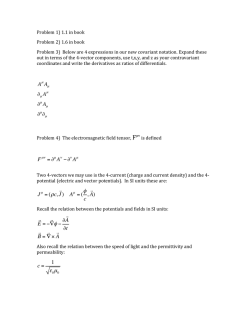
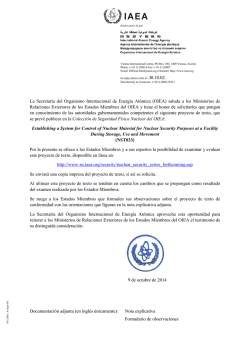
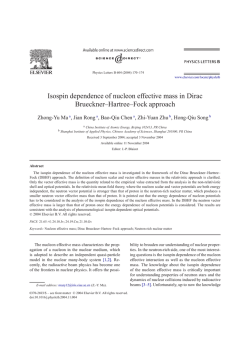
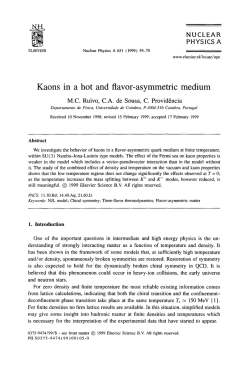
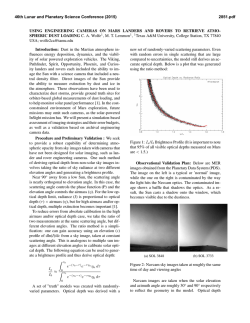

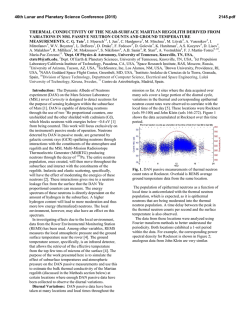
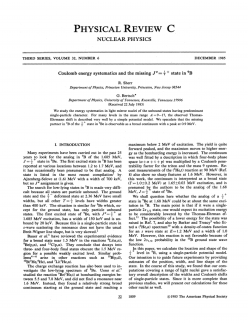
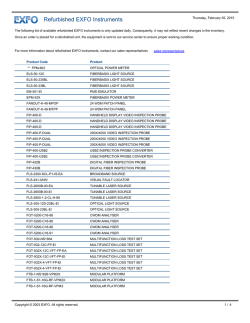

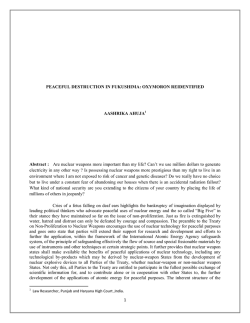
![Download the PDF [178 KB]](http://s2.esdocs.com/store/data/000499344_1-7f4373c1afe39f332b14a8d11d1a7c7f-250x500.png)
